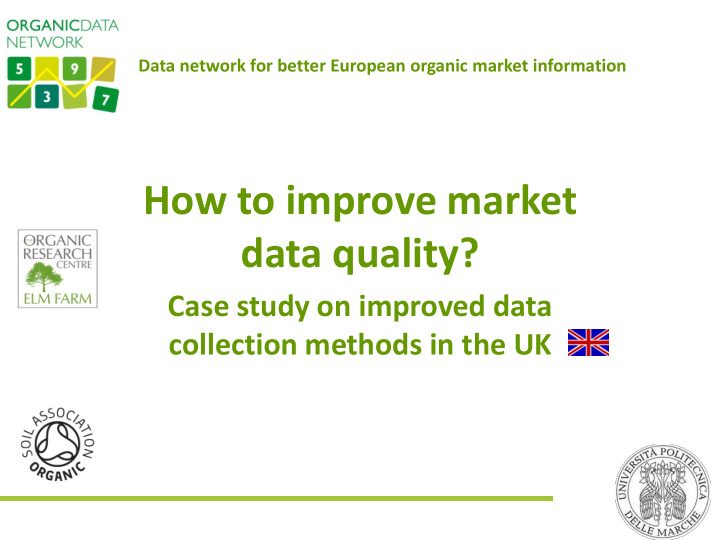



Data network for better European organic market information How to improve market data quality? Case study on improved data collection methods in the UK
Current status market data collection Production data Collected by CBs as part of inspection process, collated by Defra (submitted to Eurostat and publication). Scotland (SRUC) and Wales (Aberystwyth University and Organic Centre Wales) carry out annual surveys of organic producers No production volume (e.g. yields) and value data Domestic trade/market data Retail values published in the Soil Association Organic Market Report based on panel data and additional surveys of Soil Association certified businesses.
Data gaps and issues There is no producer survey carried out in England and the Welsh survey may be at risk due to funding constraints. Time delay in publication of production data (due to lack of harmonisation in reporting) limits usefulness to stakeholders. Limited data on retail sales through non-multiple sales channels such as independent retailers, box schemes, farm shops, and farmers’ markets. There is limited data on catering sales. Very limited (if any) data on organic imports to the UK and exports from the UK. Limited price data at farm and retail level 3
Areas of improvement: UK case study The Organic Research Centre and the Soil Association together aim to: Carry out activities to improve forecasting of production trends: Improving timeliness of publication of production data Carry out a producer survey in England. Improve data collection to obtain greater coverage of retail sales through non-multiple channels (independent retailers, box schemes, farmers’ markets, farm shops, catering). Further analysis of retail panel data from Nielsen. 4
First results – English producer survey 2589 producers and 135 producer/processors in England (Defra’s “Organic Statistics 2012 United Kingdom” publication). Contact lists (over 2000 producers) were obtained from the Soil Association and OF&G. An initial sample of 1,000 was selected at random and contacted about participation in the telephone survey. 8.2% (223) of producers completed the survey. 5
Geographical distributions SA and OF&G contacts (2000) Final sample of 223 farms
Producer survey questions General farm information Total land area and breakdown. Numbers of livestock (head) within categories. Related activities such as processing, tourism, renewable energy. Future intentions Whether remaining organic Whether retiring from farming Production levels Numbers of head of livestock sold; amount of milk, eggs sold; tonnage of crops sold Prices for milk, eggs, arable crops Opinion on organic prices High enough to continue in organic production Production intentions within the next 2 years Plans to increase, decrease or remain at similar levels Direct sales Export outside the EU
How long do respondents intend to remain organic 100 90 80 Number of respondents 70 60 50 40 30 20 10 0 up to 1 year up to 2 years 2-5 years 5 to 10 yrs 10yrs plus
Are prices sufficient to remain in organic production?
What are the plans for production in the next two years?
Progress of work Continue analysis of the producer survey data Analysis of EPOS (electronic point of sale) data from Nielsen Analysis of survey of farm shops and farmers’ markets 2014 Organic Market Report from the Soil Association is expected on 12th March. www.soilassociation.org/marketreport 11
Recommend
More recommend